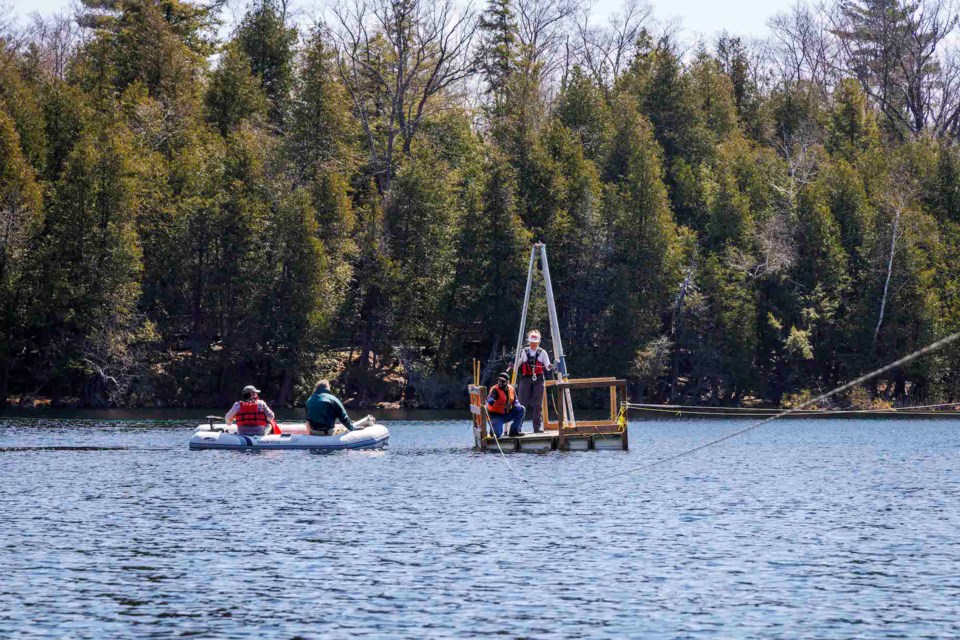NEWS RELEASE
BROCK UNIVERSITY
**************************
Two Brock University professors are among a body of international experts that has selected a location on Earth that will allow the Anthropocene to be defined as a new epoch in geologic time.
Brock professors of Earth Sciences Francine McCarthy and Martin Head, and Carleton University professor of Earth Sciences Tim Patterson, head up a team that has been studying the geology of Crawford Lake in Milton, Ont., for many years.
On July 11, the Anthropocene Working Group (AWG) — of which McCarthy and Head are voting members — announced its choice of Crawford Lake over 11 other possible sites as the location that best shows the boundary of the proposed Anthropocene, brought about by major changes to Earth through human activity.
“My main reaction to the news is relief,” says McCarthy. “I’m happy not just for me, for my colleagues and their students from a number of institutions who have been working really hard, but frankly, I’m happy for the planet.”
During their long-running research, the multi-institutional team gathered sediment from Crawford Lake through a process called ‘freeze coring’ in which organic material freezes to the outside of a hollow tube, filled with dry ice and ethanol, that is dropped into the lake’s muddy floor.
From the cores, researchers can see annual layers of sediment called varves that resemble tree rings. Varves from the mid-20th century onward contain deposits of human-made byproducts such as plutonium-239, microplastics, fertilizers and fly ash.
Crawford Lake is classified as a meromictic lake, meaning its layers of water don’t intermix. McCarthy says this characteristic, and the deepness of the lake, have enabled scientists to get an accurate record of the area’s human and natural history.
“Crawford Lake’s unique varving patterns lead to the exceptional, wonderful preservation of all of the things in it without being disturbed,” says McCarthy. “So, we can sample every year and tell you what was going on in the water, the atmosphere, the watershed.”
Head hails the choice of Crawford Lake as being “a very important step forward in the defining of the Anthropocene as a new geological time and the culmination of a huge amount of work.”
He says rapid changes in population growth, industrialization and globalization following the Second World War and the use of the atomic bomb have significantly altered the Earth.
“It’s really important that we acknowledge a momentous planetary shift in the mid-20th century as a geological term,” Head says. “Otherwise, people will think that this is really just business as usual, that the Holocene Epoch has not ended, and the changes that have occurred in recent memory are simply incremental, which we know is actually not the case.”
The July 11 announcement is the first of many steps that need to occur before a new epoch can be officially declared, a process which will take “many months,” says Head.
The AWG will forward its Crawford Lake recommendation to the International Subcommission on Quaternary Stratigraphy, of which Head is vice-chair.
The Subcommission could either accept or reject Crawford Lake as hosting the ‘golden spike,’ an internationally agreed upon reference point in rock or sediment layers that defines the lower boundary of a new stage in the geologic time scale.
If they do accept Crawford Lake, the Subcommission could either choose to recommend that the golden spike only define the beginning of the ‘Crawfordian Age’, where it would be part of the current Holocene Epoch, or define a new Anthropocene Epoch as well.
“We’re hoping the Subcommission agrees to at least a golden spike for the Crawfordian Age; I’m hoping for the Anthropocene,” says McCarthy.
Once the Subcommission makes its choice, it goes to the International Commission on Stratigraphy for a full vote. That decision is then forwarded to the International Union for Geological Sciences, which has the final say.
McCarthy says she is “happy that we have a good proposal.”
“We’re doing our level best to get the public to understand we’re at a critical juncture right now where there is probably still time to turn the ship around before it hits the iceberg, so to speak, but we need to get that message out in a way that is convincing and understandable for people who vote and those who make decisions,” she says.
**************************



